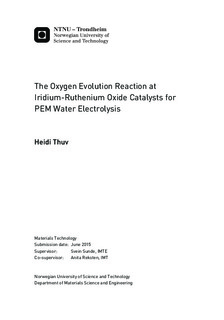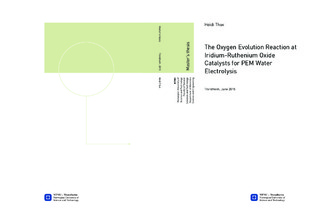| dc.description.abstract | A sustainable method for hydrogen production can be achieved with PEM water electrolysers. These are considered important for the transition to a society based on renewable energy production as they can be coupled with intermittent power sources like wind and solar power. One major challenge with this technology is the sluggish oxygen evolution in combination with the harsh conditions at the anode, requiring expensive catalyst materials. Mixed iridium-ruthenium oxides are promising electrocatalysts for the oxygen evolution reaction (OER) in these environments.
The aim of this thesis was to study the reaction mechanism of the OER and the by-products of this reaction at IrxRu1-xO2 materials, and to investigate how the composition influenced these factors. Four oxide powders (IrO2, Ir0.6Ru0.4O2, Ir0.3Ru0.7O2 and RuO2) were synthesised by hydrolysis. These were characterised by XRD, cyclic voltammetry and polarisation in the oxygen evolution potential region.
Polarisation experiments in perchlorate solutions of pH 0, 1, 2 and 3 were used to measure two kinetically significant parameters, namely the Tafel slope and the reaction order with respect to H+. Tafel slopes of approximately 40 mV and reaction orders of -1.5 were established for all oxides, and suggests that the OER take place with the same mechanism at all oxide compositions. The rate limiting step of the OER at these oxides appears to be the transition of OHads to Oads. Small variations in the Tafel slopes between the material compositions were ascribed to different intermediate coverage.
Ring-disk electrodes under hydrodynamic control were employed for detection of by-products of the reaction. The ring-disk experiments were performed under dynamic potential control to simulate the intermittent nature of renewable energy sources. The disk electrode was coated with the catalyst material to be studied, and potential step or potential sweep voltammetry was performed at this electrode while the ring electrode was held at a constant potential for detection of the reaction by-products. In addition, the electrolyte flow rate was varied, which revealed that parts of the detected ring current originated from features probably caused by the instrumentation. These features and a variable background current contribution at the ring complicated the interpretation of the ring-disk measurements. The identity of the products produced at the ring could therefore not be established. However, strong indications that at least two products other than oxygen were produced at the disk were found. One specie giving rise to a reduction at the ring and the other giving rise to oxidation. As no conclusion could be drawn concerning the identity of the by-products, the results from the ring-disk experiments could not elucidate the reaction mechanism further.
Potential sweep and potential step voltammetry at the disk resulted in different ratios of the two by-products. This demonstrates that the production of by-products depends on the potential dynamics of the oxygen electrode. It seems that different operating conditions of the electrolyser can favour different by-products and also different ratios of these two products. | |

